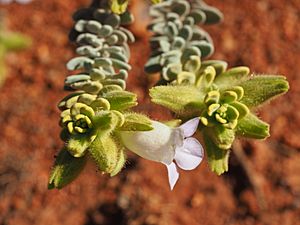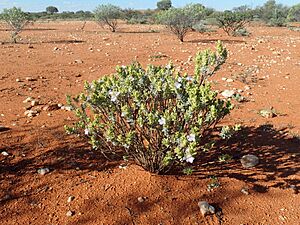Eremophila jucunda subsp. jucunda facts for kids
Quick facts for kids Eremophila jucunda subsp. jucunda |
|
|---|---|
 |
|
| E. jucunda jucunda leaves and flower | |
| Scientific classification |
|
| Kingdom: | Plantae |
| Clade: | Tracheophytes |
| Clade: | Angiosperms |
| Clade: | Eudicots |
| Clade: | Asterids |
| Order: | Lamiales |
| Family: | Scrophulariaceae |
| Genus: | Eremophila |
| Species: | |
| Subspecies: |
E. j. subsp. jucunda
|
| Trinomial name | |
| Eremophila jucunda subsp. jucunda |
|
Eremophila jucunda subsp. jucunda is a special type of plant found only in Western Australia. It belongs to the figwort family, which is also known as Scrophulariaceae. This plant is a small bush with fuzzy leaves and pretty flowers that can be white or purple. You'll often find it growing on rocky hillsides. It looks a lot like another plant called Eremophila jucunda subspecies pulcherrima. However, you can tell them apart because jucunda subspecies jucunda has bright yellow new leaves and grows further south.
Contents
What Does This Plant Look Like?
Eremophila jucunda subspecies jucunda is a shrub that usually grows to be about 0.2 to 1 meter (about 0.7 to 3.3 feet) tall. Its stems and branches are covered in tiny hairs. The leaves are packed closely together near the ends of the branches. They are shaped like a spear or an egg, measuring 8 to 20 millimeters (about 0.3 to 0.8 inches) long and 2 to 6 millimeters (about 0.08 to 0.24 inches) wide. The newest leaves and young branches are a bright yellow color.
The flowers of this plant are white, light purple, or dark purple. They grow one by one where the leaves meet the stem. Each flower has a stalk that is 3 to 9 millimeters (about 0.1 to 0.4 inches) long. There are 5 sepals, which are like small leaves that protect the flower bud. These sepals are long and narrow, measuring 9 to 17 millimeters (about 0.4 to 0.7 inches) long. The 5 petals form a tube that is 17 to 29 millimeters (about 0.7 to 1.1 inches) long. This tube is usually a bit hairy on the outside.
This plant blooms from July to September. After the flowers, it produces fruits that are oval or cone-shaped. These fruits are 5 to 9 millimeters (about 0.2 to 0.4 inches) long.

How It Got Its Name
The name Eremophila jucunda subspecies jucunda is a special type of scientific name called an autonym. This means that the subspecies has the same name as the main species, Eremophila jucunda. It helps scientists keep track of different plant groups.
Where Does It Grow?
You can find Eremophila jucunda subspecies jucunda growing on rocky flat areas or hillsides. It often grows in areas with mulga trees, which are a type of acacia. This plant is found in a large area between the towns of Sandstone and Mount Vernon in Western Australia.
Is It Safe? (Conservation Status)
The Western Australian Government's Department of Parks and Wildlife has looked at Eremophila jucunda subspecies jucunda. They have decided that it is "not threatened." This means the plant is not currently in danger of disappearing.

